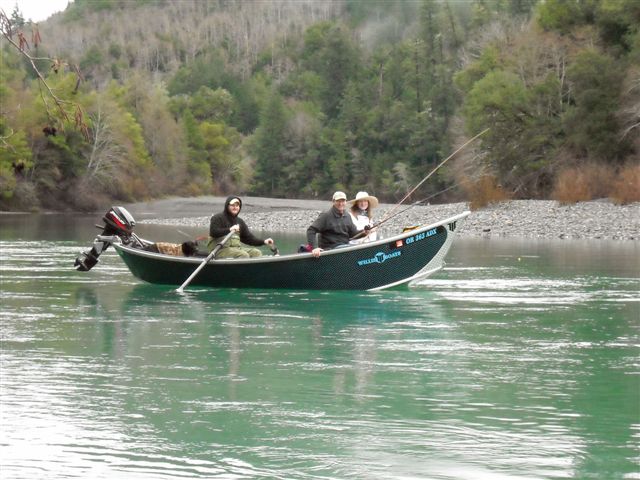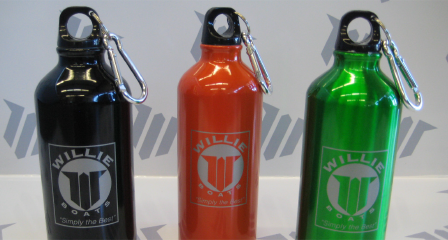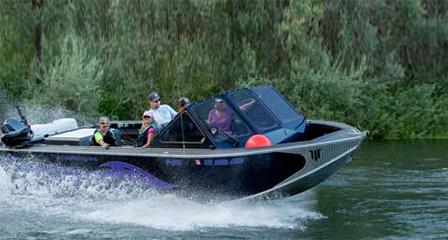Willie Blog
 March 15, 2013
Experience
March 15, 2013
Experience
How to Run a Drift Boat
Drift Boat Basics
By Willie Illingworth
Updated October 18, 2005
How to Run a Drift Boat
It is certain that there are very few boats as specialized or unique as a river drift
boat. Drift boats are riverboats, specifically designed to run rivers, and although they are
not unsinkable, they are amazingly maneuverable and seaworth, especially in the hands
of an expert oarsman. Although their popularity began in the Pacific Northwest, they are
now used in many rivers across the United States, Canada and Alaska. Although drift
boats can be used for general river running, most white water enthusiasts prefer rubber
rafts. Without question, fishermen and hunters who seek unlimited access to river prefer
the easy launching, handling, anchoring, and comfortable dryness of the solid floored
drift boat. This information is to not only help you become familiar with drift boats, but
also with drift boat handling., the basic how to’s of running a drift boat, the do’s and
don’t of drift boating. Drift boat selection, making sure to choose the right drift boat to
suit your needs, and some straight talk about river courtesy. Which in itself can be
intimidating to novice drift boaters. As a fisherman, I cannot help but point out that drift
boats not only provide access to the bank bout angler, but open up a whole new world of
fishing techniques, many of which cannot be employed from shore.If you study a drift boat’s basic design for very long, it becomes obvious why the
boat is built the way it is. Its bottom is flat from side to side, there is no keel. This wide
bottom area means that the boat draws very little water, thus able to float through shallow
riffles. The bottom is dished from the bow to the stern, which allows for quick turns and
maneuverability so the oarsman can pull the boat away from obstructions. The pointed bow is the high end which faces down stream, and in white water situations allows the boat to cut the wave and lift the boat through it. The blunt angled stern piece is just high enough to keep following waves from spilling over the side, wide enough to mount an anchor bracket, but not so wide as to spoil the turning maneuverability.
People who have had experience with conventional boats have a hard time
adjusting themselves as to how to maneuver a river drift boat in swift water. The reason
for this is that a drift boat is a little backwards. Even though the bow is the high end and
points down stream, it does not control the direction you wish to go, but rather the stern
end, and which way it is pointed, determines your destination. The key thing to remember
when starting out, if you are sitting in the row seat, which is located on the stern end of
the boat, is to pull on the oars and slow the boat down as you proceed downstream. If the
boat is drifting towards an obstacle and you wish to avoid it you turn the stern to the
direction that you wish to go and pull on the oars, thus pulling yourself away from the
object before straightening the boat out to proceed downstream. Most peoples’ inclination
is to push on the oars, which only insures that you will hit the obstacle before you can
maneuver away from it.
When maneuvering a drift boat downstream through somewhat quiet water, you
may wish to push on the oars to move downstream faster, or if you are in an extreme
white water situation with large waves, you may push on the oars to carry your boat
through those large waves, but 95% of your boat maneuvering you will be pulling on the
oars turning the boat at a 45° angle to the stream flow and pulling away from obstacles
then straightening the boat out to proceed downstream. Most classic rivers are made of a
series of pools or holes and riffles or chutes. Often times you will set-up to run a chute or
rapids and unless you are familiar with the river, you should start in the middle of the
river looking downstream trying to read the water and pull your boat away from the
obstacles. If the river tries to push you into a corner, tree or any obstacle, the key thing to
remember is to point you bow into the obstacle and the stern 45° to the flow and pull
your way away from it.
Do’s and Don’t of Drift Boating
Never anchor in deep swift water. Never cut your oars too deep when rowing, especially
in boily water. Never let go of your oars, while free floating, unless you are paying close
attention. Often times the river can grab your oar blade and result in a broken oar or a
bent oarlock. Never allow your passengers to stand-up while maneuvering white water.
Make sure that they are seated unless you are in an anchored position or perhaps in calm
water. Always carry life jackets for everyone on board and wear them if you are in any
white water situation. Always carry a spare oar and oarlock.
It is worth noting that even though drift boats are built for running rivers, and can
maneuver in white water situations, they are not unsinkable, especially in the hands of an
inexperienced oarsman in rough water. Thoroughly checkout the section of river you are
running, making sure that there are not waterfalls or heavy rapids, which exceed your
capability. There are may rivers or sections of rivers which can be handled easily by the
novice, at the same time there are sections of streams which are either unrunable, or
runable only by the very experienced oarsman. Also, just because you ran a section of
river successfully last year. For example, a tree may have fallen across the stream or
heavy winter flows may have narrowed the channel or changed the river course. Talk to
your fellow fishermen, stop in and ask at the sport shop or maybe even maintain a local
map with recommendations as to which section or sections of a stream would best meet
your qualifications. If you are really unsure on how to run the river or whether or not you
wish to invest in a drift boat, either go with a friend who has one or consider booking a
trip with a local river guide. Booking a trip with an experienced river guide can not only
help you get the feel for running the river, but you can learn the better fishing spots, and
even which lures or techniques are producing. Most sporting goods shops can
recommend the better local guides. Get several names if possible, call them and base your choice on which one your like the best.
River Courtesy
Although owning a drift boat does able an angler to get away from the crowd and
reach, otherwise, inaccessible areas, you will run across occasional bank fishermen, or
sometimes float by crowded fishing areas in an effort to reach inaccessible places. Bank
fisherman or other boat fishermen might resent you rowing over the area they are fishing,
or they might resent you anchoring right where they are casting. Also, anchoring in a
sport perhaps boats have been taking turns fishing.. Most of the time a little common
sense and a friendly hello are all that is required.
Here are a few things that you might keep in mind, as you maneuver downstream
keep an eye out for other boats and bank fisherman. If you see a bank angler, try and
watch where he is casting, if he is casting short then you may wish to run the river on the
opposite side, the same would be true if the river bank was considerably congested, then
you would be safe to run the river on the opposite the populated shore. If an angler is
casing all the way across the river, fishing the obvious pocket on the far side, then you
may wish to maneuver close to him, avoiding running your boat over the top of the area
he is trying to fish. If there is a boat rowing in the current, running plugs (backtrolling),
the worst thing that you could do is to drop downstream just below him and begin
casting. Usually when drift boats setup to backtroll plugs, through a drift, they fully
intend on fishing all the way through that hole and either rowing back up to the top and
running again or proceeding downstream. If there is a boat pulling plugs in the river, you
could either setup to pull the plugs beginning upstream from him or if you intend on
casting you may wish to wait until after he has covered the water once. Likewise, if there
is a boat anchored casting, it would be rude for you to pull plugs through the water that
angler has been working. It is no different than anything else in life – try your best to
treat people as you would like to be treated and keep in mind that part of being a
sportsman is learning to share and although probably not everyone would agree. It is my
personal feeling that boats do not scare fish, except in critically low clear water
conditions.







